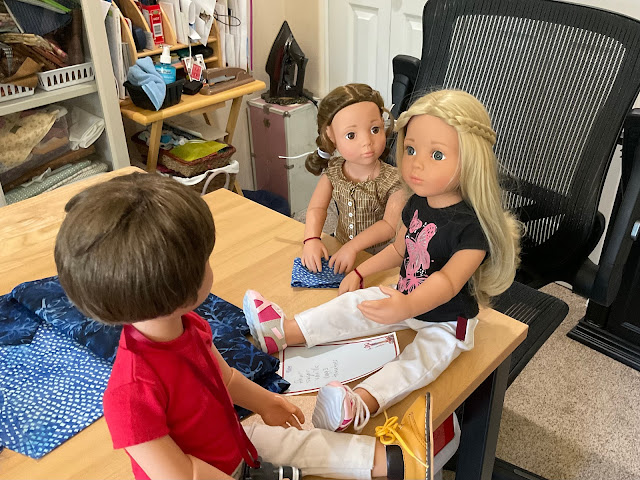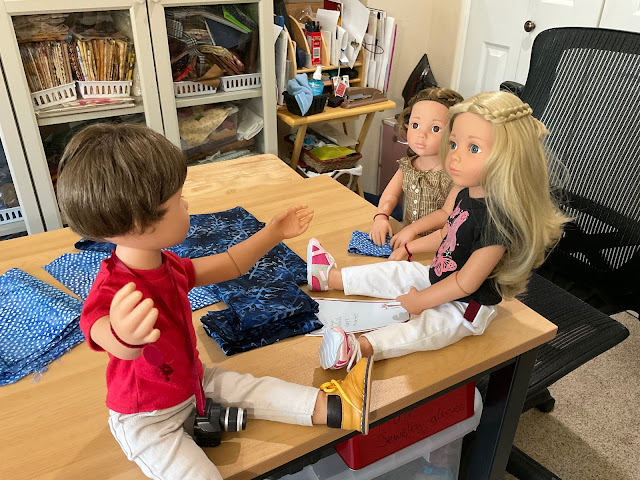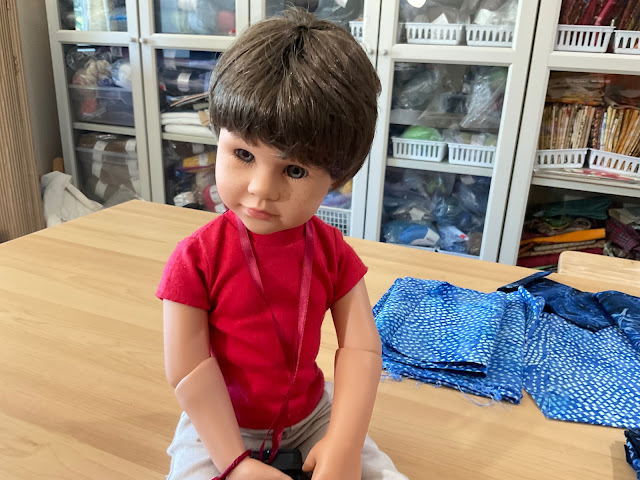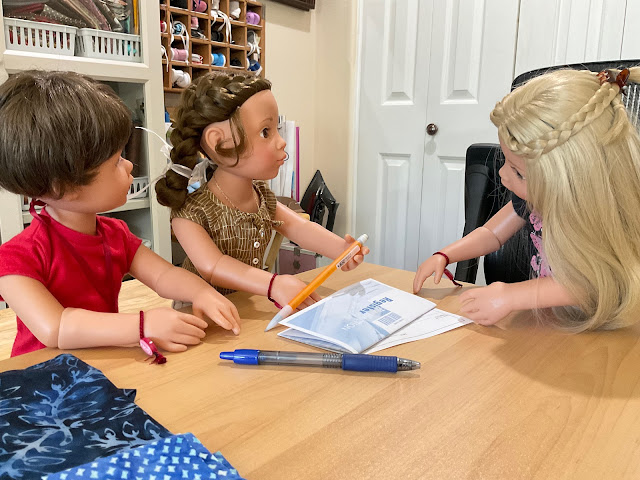"Where's The Writer," Jolena asked. "I've been baking, and there are some things we should get from the store when she goes next time, so we don't run out. I made a list."
"I saw her go into the study," Billy told her. "That was just a few minutes ago. She said something about balancing her checkbook."
"Balancing it on what?" Jolena asked. Jolena takes dance lessons and gymnastics lessons to help her the tricks she does on her skis. Balance is an important part of how she uses her body.
"I don't know," Billy replied. "Should I go take a photo?" What Jolena said just made him think that however The Writer balanced her checkbook, it might make a good photo.
Veronika, who had been busy folding fabric scraps for a quilt at the table, had been listening. She smiled at the thought of The Writer balancing the checkbook on her nose, like a trained seal with a ball. She was careful not to laugh, though, because there is no way a doll can know something they haven't had experience with, and she didn't want to hurt their feelings. Jolena and Billy were just drawing conclusions based on their experience, which didn't include balancing a checkbook...yet.
"It isn't that kind of balancing," she said.
Jolena and Billy turned around and looked at Veronika. She knew they expected her to explain.
"Do either of you know what a checkbook is?" Veronika asked, and then waited for them to think.
"Maybe it's something" Billy suggested, "The Writer uses to keep a list of the things she has to do, so she can check them off when they're done." That made sense to him.
"I have an idea," Jolena said. "I think she uses something called a check to pay for things sometimes. When we went to the store to return the empty bottles and cans, I got to go in with her to get the money for them."
"The Writer bought some things in the store," Jolena continued, remembering. "She told the cashier––that's the human person who adds up how much each thing costs and tells you how much you have to pay––I heard her tell the cashier she wanted to pay with a check."
Veronika nodded.
"While the cashier put her things in a bag," Jolena went on, "The Writer took out this sort of folder thingy. It could have been a book. She wrote in it how much she had to pay. Then she tore out the page and gave it to the cashier."
"So was that folder thingy her checkbook, maybe?" Jolena asked.
"That's right," Veronika agreed, "although Billy's guess was a good one. The Writer is always making lists of things she has to do or buy."
"So how does she balance it," Billy asked, "and why?"
"Well," Veronika began, "First, you need to know how checks work in place of money. What if you had $1 for your allowance, and you needed to buy something for your camera?"
"I can't think of anything I could buy for my camera with only $1," Billy replied. "I would have to save up. I'd like to buy a special lens for taking closeups, but I would need a lot more than a dollar."
"How do you save your money, Billy?" Veronika asked.
"I have a jar for savings," Billy replied. "I also have a jar for spending. When I get my allowance, I put half of it in the jar for savings and the other half in the jar for spending, but if I need something that costs a lot, sometimes I put more of it in the savings jar. That way, I can buy the thing I need sooner."
"Well," said Veronika, "What you use is cash. That's like coins and paper money. The Writer has more money than she can keep in a jar, so she keeps a bank account. When she wants to spend some of it, she could go and get cash, or she can can write a check or use her credit card. Some places where she spends money they like her to write a check if she doesn't have cash. They can take the check and deposit the money in their own bank account. Their bank then uses the check to get the money from The Writer's bank."
"Now," Veronika continued, "if The Writer wrote checks for more money than she has in the bank, what do you suppose would happen?"
Jolena tried to make her eyes get big and round, but of course, she could only pretend to. "The bank wouldn't have enough of her money to give to the store!" she exclaimed. "What would they do?"
"The check would bounce," Veronika said.
"Like a ball?" Billy wanted to know. "The only way I know to make paper bounce is to crumple it up into a ball."
"Not exactly like a ball," Veronika explained. "It just means instead of taking money from The Writer's account, it goes back to The Store's bank instead of the money."

"First the Bank will mark it insufficient funds," Veronika said. "Insufficient is a way of saying not enough. What do you think funds means?"
"If it isn't enough of something in the bank, it must be money." Billy guessed.
"Yes," Veronika agreed. "Money to pay for something is called funds."
"The store wouldn't get their money." Jolena said. "That's wrong! You shouldn't take things you haven't paid for!"
"The Writer wouldn't want to do that!" Billy said emphatically.
"The store would have to call The Writer and ask her to bring them the money or put more money in her bank," Veronika said. "That would be very embarrassing. That's why she balances her checkbook carefully," Veronika said. "You have to write down everything, so you know how much money you have. Whenever you get money and deposit it––that means you add it to your bank account––you write in your checkbook the amount. When you write a check, you write that down, too."
"I have an idea!" Veronika said then. "I'll show you how to do it. It will be easier to understand if I show you."
Veronika dug through some things where The Writer keeps her supplies until she found what she was looking for. "This," she said, " is a check register. It's the part where the balancing is done. It fits in the checkbook on one side, and the checks fit on the other."
"And," Veronika went on, pulling out a slip of paper, "here's a practice check. I can show you how to write a check. She used one of these to teach me."
"Then we can write it down in the register," Veronika explained. "We'll write it down in pencil, so The Writer can erase it if she needs to use the register."
"Let's say," Veronika said, "that The Writer has $100 in her bank account. She would write that amount here." Veronika wrote it down in the right place at the top of the page in the register.
"Now let's pretend she's at the store," Veronika continued. "Let's write the check. First we write the date here," she explained, writing the date in the right place on the check. She showed them the check with the date she had written on it.
"Next we write down who gets the money," Veronika continued, writing down "The Store" in the right place for who gets the money.
"Then," Veronika went on, "we write down the amount two different ways: first as numbers and then as words." She wrote down $25.00/100 in the right place for the numbers. "You can write $25.00 just like that," she explained. Next she wrote Twenty-five and no/100 in the place for the words.
"I think I see," said Jolena. "That's so if it's hard to read one place, you can look at the other place."
Veronika nodded. "You're exactly right," she agreed.
"Is 'no/100' the same as zero cents?" asked Billy. "There are 100 pennies in a dollar."
"You know a lot already," Veronika agreed. "You're both right!" Then she signs the check down at the bottom." Veronika signed for The Writer, because it's not a real check. (She would never sign a real check with The Writer's name!) She showed them the check.
"Now you can give the check to the cashier," Veronika said.
"Now comes the most important part," Veronika went on.
"Is this where we do the balancing?" Jolena asked, standing on one foot.
"Almost," Veronika said. "The Writer writes down the number of the check here in the register. The number is always printed on the check, up here in the right-hand corner, but the practice checks don't have numbers, so we'll just pretend this one is 1" She wrote the number 1 in the right place in the register.
"Then," she said, "we put the date of the check here, and then who gets the money." She wrote the date and then The Store.
"Next comes the amount of the check," Veronika said, as she wrote in $25.00. Veronika looked at the two younger dolls.
"Now," she said, "how do we find out how much is left?"
"We subtract the $25 for the check from the $100," I think. Jolena said. We did something like this in my class."
"Right," Veronika agreed. "Now how much is left in the account?" She paused and waited for their answer, to let them think.
"Seventy-five dollars," they both said at once. Veronika wrote it down, because they were right.
"You do that each time you write a check," Veronika told them. "Then, once a month, you get a letter from the bank that tells you what you should have in your register. It's called a statement. It has a list of all the checks they paid for you, with their numbers and dates, who got the money, and how much each one was for. You balance the checkbook by making sure it agrees with the statement."
"You may have some checks you've written, but the bank hasn't seen yet, because they may be too new or The Store is holding on to them until they have enough checks to take to the bank, so it may look like you have more money than you have. If you forgot to write down a check, you may have less than you thought."
Jolena and Billy were starting to look glassy-eyed, which is pretty normal for them, being dolls, you know, but Veronika decided that was enough for now, and this story is already long enough.
"If your total in your checkbook doesn't match the total in the statement from the bank," she said, "you get to play detective to find out why. Maybe we can talk about that another day," she concluded, and closed up the register.
"I just made some cookies!" Jolena exclaimed. "Let's go pretend to eat some!"
"Cookies will help us balance our diet," said Billy. "We already pretended to eat egg salad sandwiches and apples for lunch." (Billy believes in a balanced diet.)
Veronika: Götz Classic Kidz Vroni
Jolena: Götz Happy Kidz Lena in Aspen
Billy: Götz Happy Kidz Lily at London
"The Doll's Storybook" is not affiliated with Gotz Dolls USA Inc. or Götz Puppenmanufaktur International GmbH.
Watch for the next story each Friday afternoon at 1:00 PM Pacific Time.
<a href="https://www.bloglovin.com/blog/19832501/?claim=j3fj3mbb8kt">Follow my blog with Bloglovin</a>
Copyright © 2022 by Peggy Stuart



















































No comments:
Post a Comment